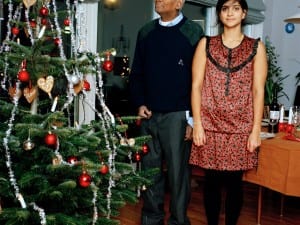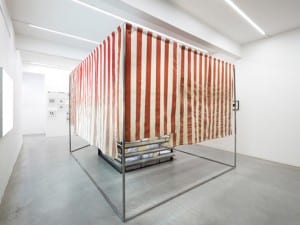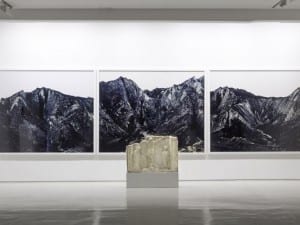Just one step in through the door of Ayyam Gallery, London, the viewer will find themselves face-to-face with an uneven, flaking, grey-brown surface. Looking along the vertical plane it becomes clear that its material is concrete and its form is familiar from numerous newspaper images; it is a model wall, built as a representation of the West Bank Barrier. The wall fills a considerable portion of the room, partitioning the already slim gallery space into two claustrophobic corridors of artworks.
A video shows the artist chipping sections from the real version of this wall with hammer and chisel. The concrete he obtains is used in sculptural works, which in this show take the form of popular sports equipment; items include a football and a discus. Situated on white plinths the objects are grey and leaden and lack any sense of movement or potential. The starkest contrast is provided by a basketball, which in the absence of any elasticity seems sadly impotent. Through these material substitutions the qualities of the concrete are projected back upon the wall from which it was obtained.
The sporting thematic continues. From the far end of the gallery voices can be heard, though mostly they just repeatedly shout the word “ready”. The image is of two men playing an ineffectual game of badminton over the barrier. With rallies rarely lasting more than two strokes, it is fairly clear that this isn’t the ideal net to play with. As the game persists it becomes humorous to the point of farce.
Moving to the far side of the gallery, a series of photographic works hang in the shade of the wall. The images are mostly dominated by black space, and where patches of form do exist, the impression is given that the pictures have been taken covertly, through gaps in a fence or in car wing mirrors. The subjects of the photographs are a number of Israeli roadblocks. The images were first exhibited on the fences facing out towards these Israeli blockades, protest by means of reflection.
In the exhibition literature the wall is referred to by its unofficial Palestinian title, The Apartheid Wall a much stronger wording than the official Israeli caption of Security Fence. In this exhibition, however, it is the wall’s physical presence that provides political commentary rather than any name ascribed to it. The whole show is curated cumbersomely around this ungainly barrier, which acts as an unabashed metaphor for the impediment caused by its original.
At the end of the model wall is a crack. It takes the shape of an uneven diamond, its bottom pointed and its top right corner distended and straggly. It is the shape of the combined states of Israel and Palestine, simultaneously an allusion to the daily crossing of the West Bank Barrier necessary for numerous Palestinians on a daily basis and a small aperture of hope. I climb through it and exit the gallery.
Khaled Jarrar: Whole in the Wall, until 3 August, Ayyam Gallery, 143 New Bond Street, 1st Floor, W1S 2TP.
Travis Riley
Credits
1. Khaled Jarrar, Installation view of Whole in the Wall, 2013, Photo credit Tim-Roberts.co.uk, Courtesy the artist and Ayyam Gallery.





